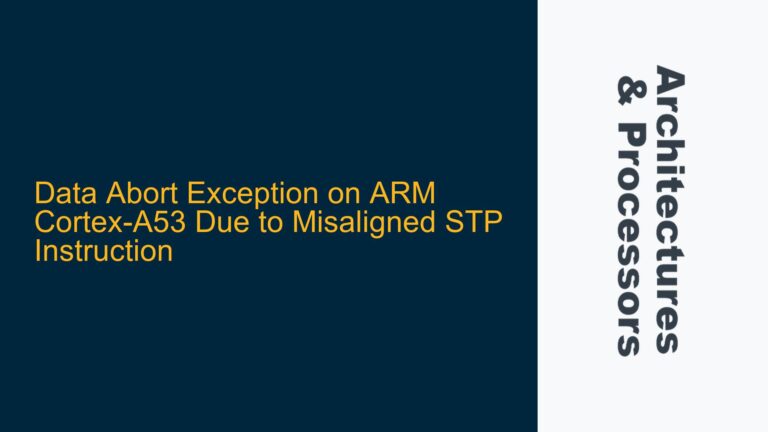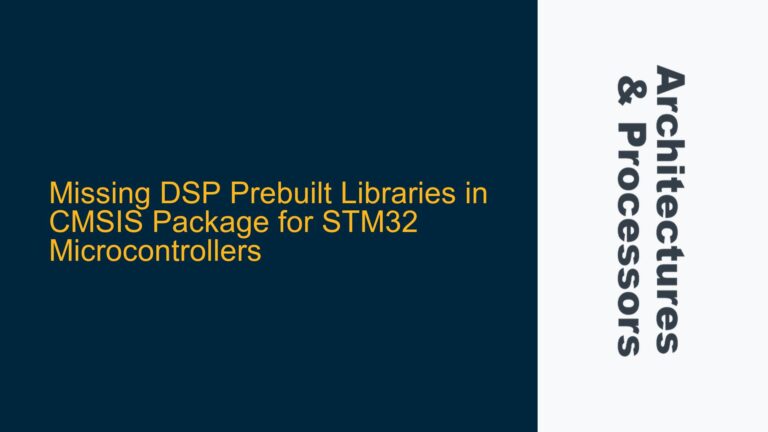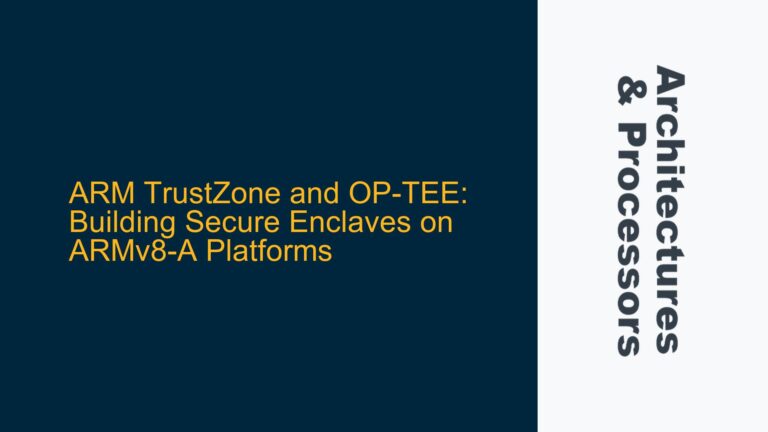ARM Cortex-M4 Frame Pointer Behavior with -fno-omit-frame-pointer
The issue at hand revolves around the unexpected behavior of the frame pointer (FP) when compiling code for the ARM Cortex-M4 processor using the -fno-omit-frame-pointer compiler flag. The user expects the frame pointer to be present in the call stack, similar to how it appears in the ARM Cortex-R series. However, the disassembly of the compiled code reveals that the frame pointer is not being utilized as expected. Instead, the stack frame is managed using the r7 register, which is not explicitly labeled as the frame pointer in the disassembly output. This discrepancy raises questions about the compiler’s handling of the frame pointer in the Cortex-M4 architecture and its implications for debugging and stack trace analysis.
The Cortex-M4, being a member of the ARMv7-M architecture, has a different calling convention and stack frame management strategy compared to the Cortex-R series, which is based on the ARMv7-R architecture. The Cortex-M4 is optimized for low-power, real-time applications, and its instruction set and register usage reflect this design philosophy. The absence of an explicit frame pointer in the disassembly output is not necessarily a bug but rather a consequence of the Cortex-M4’s architectural constraints and the compiler’s optimization strategies.
To understand this behavior, it is essential to delve into the specifics of the ARM Cortex-M4 architecture, the role of the frame pointer in stack frame management, and how the compiler interprets the -fno-omit-frame-pointer flag in this context. The Cortex-M4 uses the Thumb-2 instruction set, which is a mix of 16-bit and 32-bit instructions designed to provide a balance between code density and performance. The Thumb-2 instruction set includes specific instructions for managing the stack frame, such as PUSH and POP, which are used to save and restore registers, including the link register (lr) and the stack pointer (sp).
In the Cortex-M4, the r7 register is often used as the frame pointer, but this is not explicitly indicated in the disassembly output. The r7 register is part of the low registers (r0-r7) that can be accessed with shorter instructions, making it a preferred choice for stack frame management. When the -fno-omit-frame-pointer flag is used, the compiler is instructed to maintain the frame pointer, but the specific register used for this purpose may vary depending on the target architecture and the compiler’s optimization strategies.
The Cortex-R series, on the other hand, uses a different calling convention and stack frame management strategy. The Cortex-R series is designed for high-performance real-time applications and has a more complex instruction set that includes explicit support for frame pointers. In the Cortex-R series, the frame pointer is typically stored in the fp register, and the disassembly output explicitly shows the use of this register for stack frame management.
The difference in behavior between the Cortex-M4 and Cortex-R series can be attributed to the architectural differences between the two processor families. The Cortex-M4 is optimized for low-power, real-time applications, and its instruction set and register usage reflect this design philosophy. The Cortex-R series, on the other hand, is optimized for high-performance real-time applications and has a more complex instruction set that includes explicit support for frame pointers.
Compiler Behavior and Architectural Constraints in Frame Pointer Usage
The behavior of the compiler when using the -fno-omit-frame-pointer flag is influenced by several factors, including the target architecture, the specific compiler version, and the optimization level. In the case of the ARM Cortex-M4, the compiler’s handling of the frame pointer is influenced by the architectural constraints of the Cortex-M4 and the Thumb-2 instruction set.
The -fno-omit-frame-pointer flag instructs the compiler to maintain the frame pointer, but the specific register used for this purpose may vary depending on the target architecture. In the Cortex-M4, the r7 register is often used as the frame pointer, but this is not explicitly indicated in the disassembly output. This behavior is consistent with the Cortex-M4’s architectural constraints and the Thumb-2 instruction set, which prioritize code density and performance over explicit frame pointer usage.
The Cortex-M4’s Thumb-2 instruction set includes specific instructions for managing the stack frame, such as PUSH and POP, which are used to save and restore registers, including the link register (lr) and the stack pointer (sp). The r7 register is part of the low registers (r0-r7) that can be accessed with shorter instructions, making it a preferred choice for stack frame management. When the -fno-omit-frame-pointer flag is used, the compiler is instructed to maintain the frame pointer, but the specific register used for this purpose may vary depending on the target architecture and the compiler’s optimization strategies.
In contrast, the Cortex-R series uses a different calling convention and stack frame management strategy. The Cortex-R series is designed for high-performance real-time applications and has a more complex instruction set that includes explicit support for frame pointers. In the Cortex-R series, the frame pointer is typically stored in the fp register, and the disassembly output explicitly shows the use of this register for stack frame management.
The difference in behavior between the Cortex-M4 and Cortex-R series can be attributed to the architectural differences between the two processor families. The Cortex-M4 is optimized for low-power, real-time applications, and its instruction set and register usage reflect this design philosophy. The Cortex-R series, on the other hand, is optimized for high-performance real-time applications and has a more complex instruction set that includes explicit support for frame pointers.
The compiler’s behavior when using the -fno-omit-frame-pointer flag is also influenced by the specific compiler version and the optimization level. In the case of the ARM Cortex-M4, the compiler’s handling of the frame pointer is influenced by the architectural constraints of the Cortex-M4 and the Thumb-2 instruction set. The -fno-omit-frame-pointer flag instructs the compiler to maintain the frame pointer, but the specific register used for this purpose may vary depending on the target architecture.
Strategies for Ensuring Frame Pointer Consistency in Cortex-M4 Debugging
To ensure consistent frame pointer usage in the ARM Cortex-M4, it is essential to understand the architectural constraints and the compiler’s behavior when using the -fno-omit-frame-pointer flag. The following strategies can be employed to ensure that the frame pointer is used consistently in the call stack, even if it is not explicitly labeled as such in the disassembly output.
First, it is important to recognize that the r7 register is often used as the frame pointer in the Cortex-M4, even though it is not explicitly labeled as such in the disassembly output. When analyzing the call stack, it is essential to consider the r7 register as the frame pointer, as it is used for stack frame management in the Cortex-M4. This understanding is crucial for accurate stack trace analysis and debugging.
Second, it is important to use the appropriate compiler flags and optimization levels to ensure that the frame pointer is maintained in the call stack. The -fno-omit-frame-pointer flag instructs the compiler to maintain the frame pointer, but the specific register used for this purpose may vary depending on the target architecture. In the case of the Cortex-M4, the r7 register is often used as the frame pointer, and this behavior should be taken into account when analyzing the call stack.
Third, it is important to use debugging tools that are aware of the Cortex-M4’s architectural constraints and the compiler’s behavior when using the -fno-omit-frame-pointer flag. Debugging tools that are specifically designed for the Cortex-M4 can provide more accurate stack trace analysis by recognizing the r7 register as the frame pointer, even if it is not explicitly labeled as such in the disassembly output.
Finally, it is important to consult the compiler documentation and the ARM architecture reference manual to understand the specific behavior of the compiler and the target architecture when using the -fno-omit-frame-pointer flag. The compiler documentation may provide additional insights into the specific register usage and optimization strategies employed by the compiler, while the ARM architecture reference manual can provide detailed information on the Cortex-M4’s architectural constraints and stack frame management strategies.
In conclusion, the absence of an explicit frame pointer in the disassembly output of code compiled for the ARM Cortex-M4 using the -fno-omit-frame-pointer flag is not necessarily a bug but rather a consequence of the Cortex-M4’s architectural constraints and the compiler’s optimization strategies. By understanding the role of the r7 register as the frame pointer in the Cortex-M4, using the appropriate compiler flags and optimization levels, and employing debugging tools that are aware of the Cortex-M4’s architectural constraints, it is possible to ensure consistent frame pointer usage in the call stack and achieve accurate stack trace analysis and debugging.






